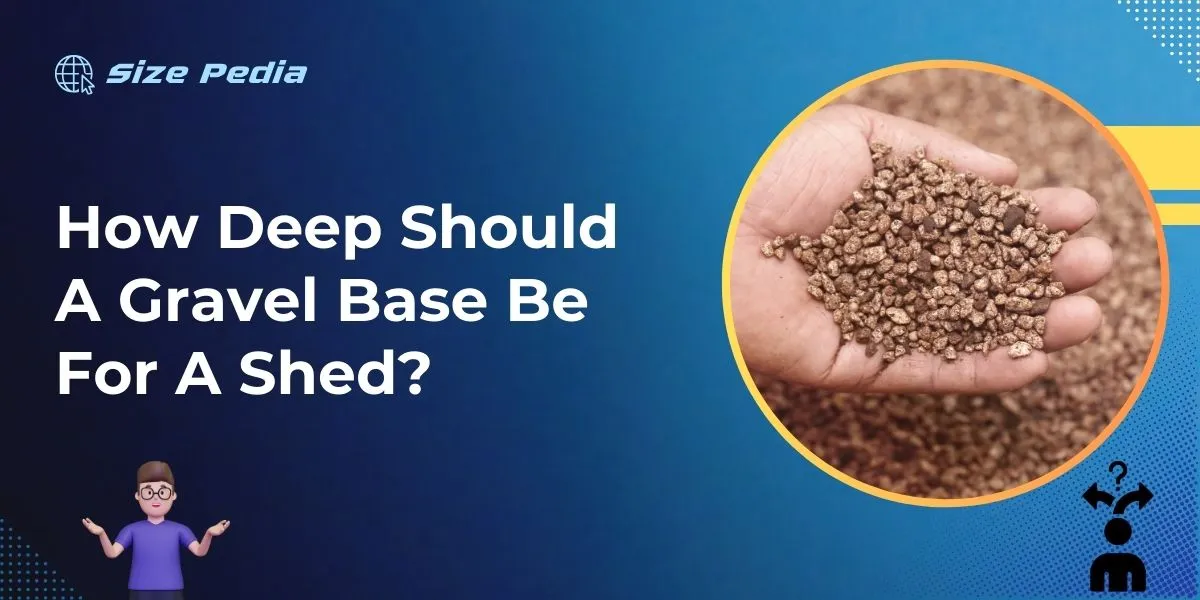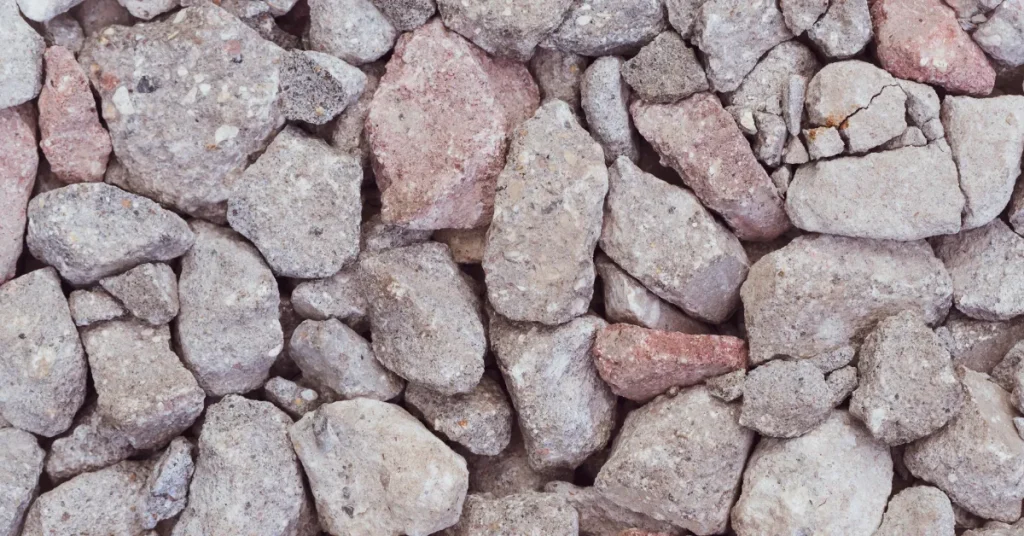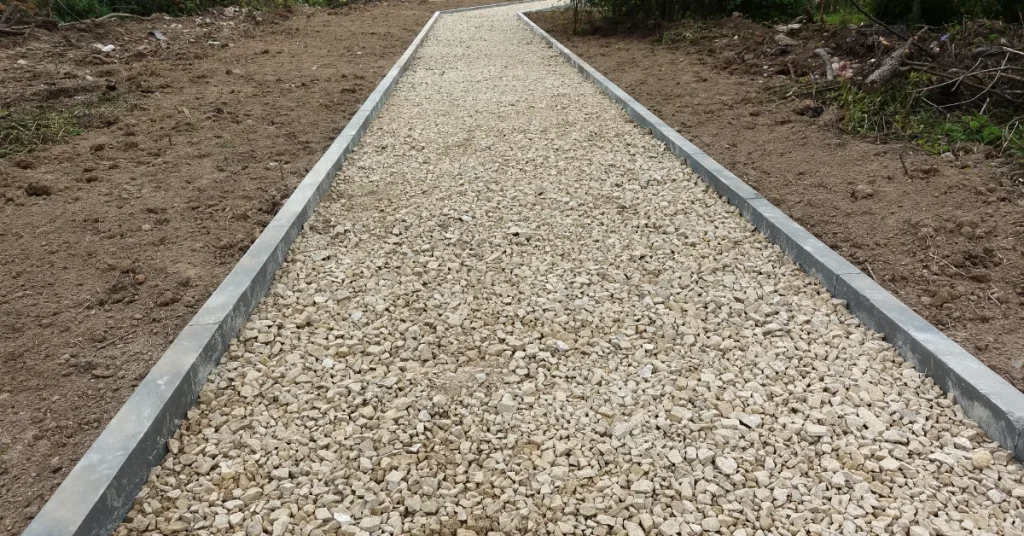A gravel base for a shed should generally be about 4 to 6 inches deep. This depth provides stable support and drainage.
Creating a robust and reliable gravel base for a shed is vital for the longevity and stability of the structure. Before embarking on your shed installation project, understanding the importance of a proper foundation can save you time and money in the long run.
A well-laid gravel base prevents settlements and water damage, ensuring your shed remains level and dry.
This introductory guide offers insights on the right depth for your gravel base, thereby contributing to a hassle-free setup. Keep in mind that local building codes and soil conditions can influence the exact depth required for your project.

Ideal Depth For Gravel Shed Foundations
The ideal depth for a gravel shed foundation ensures stability and drainage for your outdoor structure. Choose the right depth to prevent structural issues in the future.
Factors Influencing Gravel Depth
Several elements affect how deep your gravel base should be:
- Shed Size: Larger sheds require thicker gravel bases for support.
- Soil Type: Sandy soils drain better than clay and may need less gravel.
- Climate: Areas with heavy rainfall need deeper bases for proper drainage.
- Shed Use: Storage sheds may need less depth compared to workshops.
- Weight Inside: The more weight inside, the deeper the base should be.
Typical Measurements For Different Shed Sizes
The standard depth can vary based on shed dimensions:
| Shed Size (Feet) | Gravel Depth (Inches) |
| 6×8 – 8×10 | 4 – 6 |
| 10×12 – 12×16 | 6 – 8 |
| 14×20 and up | 8 – 12 |
Remember: Always add more depth to the base in wet climates or for heavy loads.
Assessing Your Shed Needs
Before laying a gravel base for your shed, it’s crucial to consider various factors. These factors influence the depth and type of base required. This way, you ensure a sturdy and long-lasting foundation for your outdoor structure.
Evaluating Shed Purpose
The planned use of your shed plays a big part in your preparation. Will it store light gardening tools or heavy equipment? Different purposes demand specific base strengths. A simple storage area may not need a deep base. A workshop loaded with machinery will, though.
Estimating Shed Weight
Calculate the total weight your shed will support. This includes the shed itself, items inside, and any additional weight from snow or roof storage.
Use this estimate to determine the gravel base depth required for support. A heavier shed needs a thicker base to distribute weight evenly.
| Shed Weight | Suggested Base Depth |
| Lightweight Shed | 4-6 inches |
| Medium Shed | 6-8 inches |
| Heavyweight Shed | 8-12 inches |
Future-proofing Shed Foundations
Think about the future. Will you add more items? Plan for possible changes. Choosing a gravel base that’s too shallow can lead to issues later.
A slightly deeper base now can save time and money in the long run. Always err on the side of caution to avoid foundation problems.
- Consider potential upgrades
- Plan for increased load over time
- Opt for a slightly deeper base for versatility
Ground Preparation Steps
Before a shed graces your yard, the right preparations ensure its longevity. A solid gravel base is crucial for stability and drainage. Below are the essential ground preparation steps you need to follow:
Clearing The Site
Start with a clean slate. Remove all debris, rocks, and roots. Clear the ground of any vegetation. This prevents organic material from decomposing under your shed, which can lead to uneven settling. Here’s a quick list to ensure a thorough clear-out:
- Mark the area: Outline your shed’s footprint with stakes and string.
- Clear within the lines: Keep the borders in mind as you remove the top layer of grass and soil.
- Dispose of waste responsibly: Recycle or use a compost pile if possible.
Leveling The Ground
After clearing, focus on a level playing field. Uneven ground can lead to structural issues. Use these steps to get it right:
- Check for levelness: Use a long level or straight edge with a level.
- Remove high spots: Shave them down with a shovel.
- Fill low areas: Apply gravel or soil to raise and even out the surface.
Compacting The Soil
A firm foundation is non-negotiable. Compacted soil beneath your gravel can prevent unwanted shifting. Achieve this by:
| Step | Action |
| 1 | Water the soil: Slightly moisten the ground to aid compaction. |
| 2 | Use the right tools: A hand tamper for small areas or a mechanical compactor for larger ones works best. |
| 3 | Compact in layers: If you’re adding fill soil, compact it in layers no thicker than 4 inches. |
Following these steps helps ensure that your gravel base will be the sturdy bedrock your shed needs to stand firm for years to come.
Gravel Type And Layering Technique

Sheds need a strong base for stability. A gravel base acts like a strong foundation. It keeps your shed safe and durable over time. The type of gravel and how you layer it matters a lot.
Choosing The Right Gravel
Selecting the right type of gravel is key. The best choice is often crushed stone. It locks together well. This makes a solid base for your shed.
You want pea gravel, too. Pea gravel has rounded edges. This helps with drainage under your shed. Both types of gravel work together.
- Crushed stone – Forms a strong base.
- Pea gravel – Ensures good drainage.
Effective Layering For Stability
Layering is just as important as gravel type. Begin with a compacted soil base. This should be flat and firm. Next, add the crushed stone layer. Aim for 3 to 4 inches deep. Over this, smooth out a pea gravel layer. This should be around 2 inches deep.
- Flatten and compact the soil base.
- Spread 3-4 inches of crushed stone evenly.
- Top with 2 inches of pea gravel.
Longevity And Maintenance Of Gravel Bases
For a garden shed, a solid foundation keeps it standing for years. A well-installed gravel base can extend your shed’s life. Proper depth varies, but the right upkeep ensures longevity. Let’s talk about maintaining a gravel base.
Preventing Weeds And Erosion
Stopping weeds and erosion is crucial for a lasting gravel shed base. Here’s how:
- Geotextile fabric: Laying this under gravel blocks weeds.
- Proper depth: Aim for at least 4-6 inches of gravel.
- Regular inspections: Check for signs of erosion.
These steps keep your base firm and intact. They prevent costly repairs down the line.
Routine Checkups And Adjustments
Routinely inspect your gravel base for any issues. Here’s what to do:
- Look for low spots: Add gravel as needed to level.
- Check for compactness: Use a hand tamper for firmness.
- Examine the perimeter: Ensure the gravel stays within bounds.
These actions help preserve the base. Doing them can avoid major problems.
Pros And Cons Of Gravel Shed Bases

Choosing the right foundation for a shed is crucial. A gravel base offers several benefits and some drawbacks. Let’s delve into the pros and cons of using gravel as a foundation for your shed.
Benefits Of Gravel Foundations
- Enhanced drainage: Gravel prevents water accumulation.
- Accessibility: Easily procure and set up gravel.
- Cost-effective: Less expensive compared to concrete.
- Versatility: Suits various shed sizes and shapes.
- Easy to level: Adjusting the gravel surface is simple.
Potential Drawbacks To Consider
- Weed growth: Weeds may sprout between stones.
- Maintenance: Periodic leveling and adding gravel is needed.
- Limited stability: Gravel may shift over time.
- Attracting pests: Small critters can burrow in gravel.
FAQs About How Deep Should A Gravel Base Be For A Shed
What Is The Ideal Depth For A Shed Gravel Base?
A proper gravel base depth for a shed should be about 4-6 inches. This allows for adequate drainage and stability. Ensure the gravel is compacted to prevent settling and shifting of the shed over time.
Does Gravel Thickness Affect Shed Stability?
Yes, gravel thickness can greatly impact shed stability. A base less than 4 inches may not support the shed adequately, leading to structural issues. Conversely, a too-thick base could be unnecessarily costly without adding benefits.
Can I Use Pea Gravel For My Shed Foundation?
Pea gravel can be used for shed foundations, but it’s not ideal. Its round shape doesn’t compact as well as crushed stone, potentially affecting the stability. It’s better suited for areas that require drainage rather than solid support.
How Much Gravel Do I Need For A 10×12 Shed?
For a 10×12 shed, you’ll need approximately 1. 48 cubic yards of gravel when aiming for a 4-inch deep base. Always buy a bit extra to account for compaction and settling, ensuring your base remains level and stable.
Conclusion
Selecting the right gravel base depth is crucial for your shed’s longevity. Generally, 4-6 inches suits most sheds.
Remember, the perfect depth depends on your shed’s size and local soil condition. Ensure a robust foundation and rest easy, your shed stands on solid ground, ready to withstand the elements.
Resources:
1. https://www.epa.gov/nps/gravel-roads-maintenance-and-design-manual
